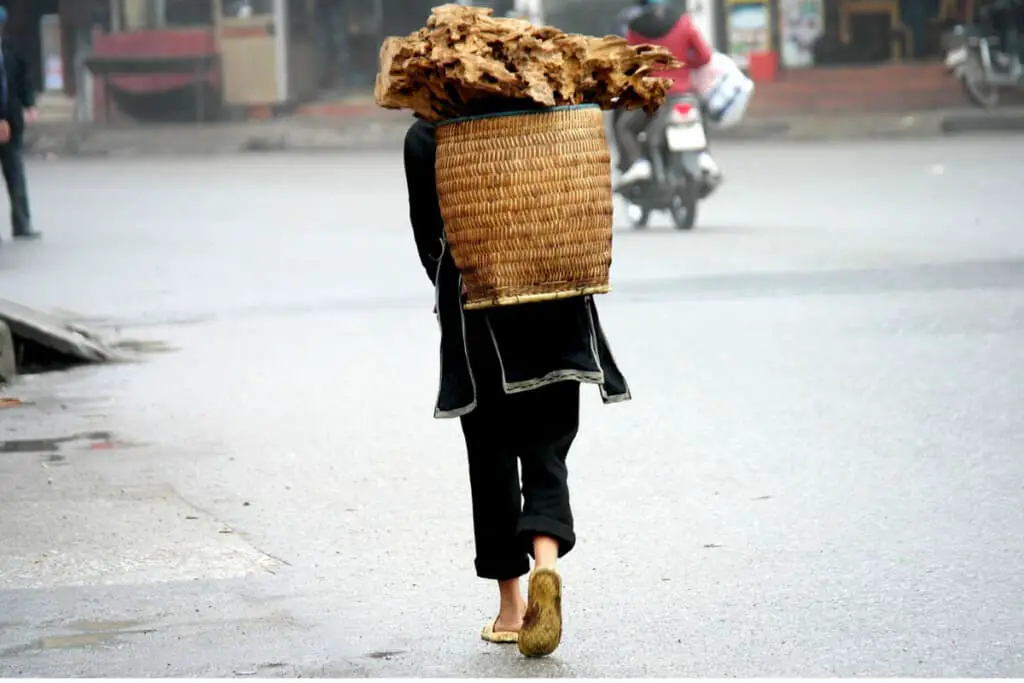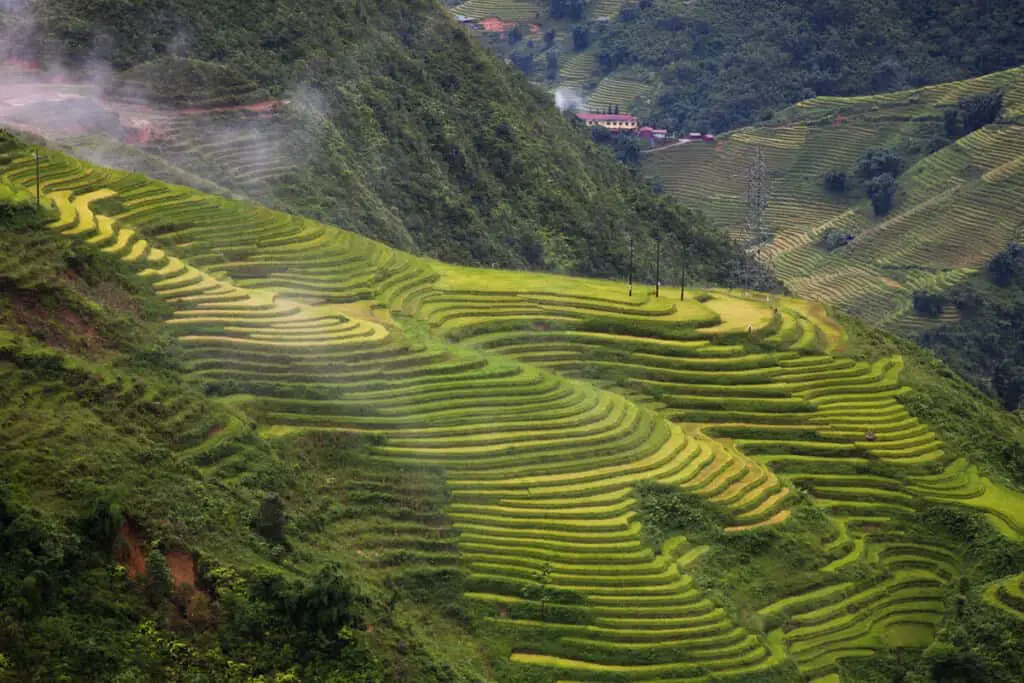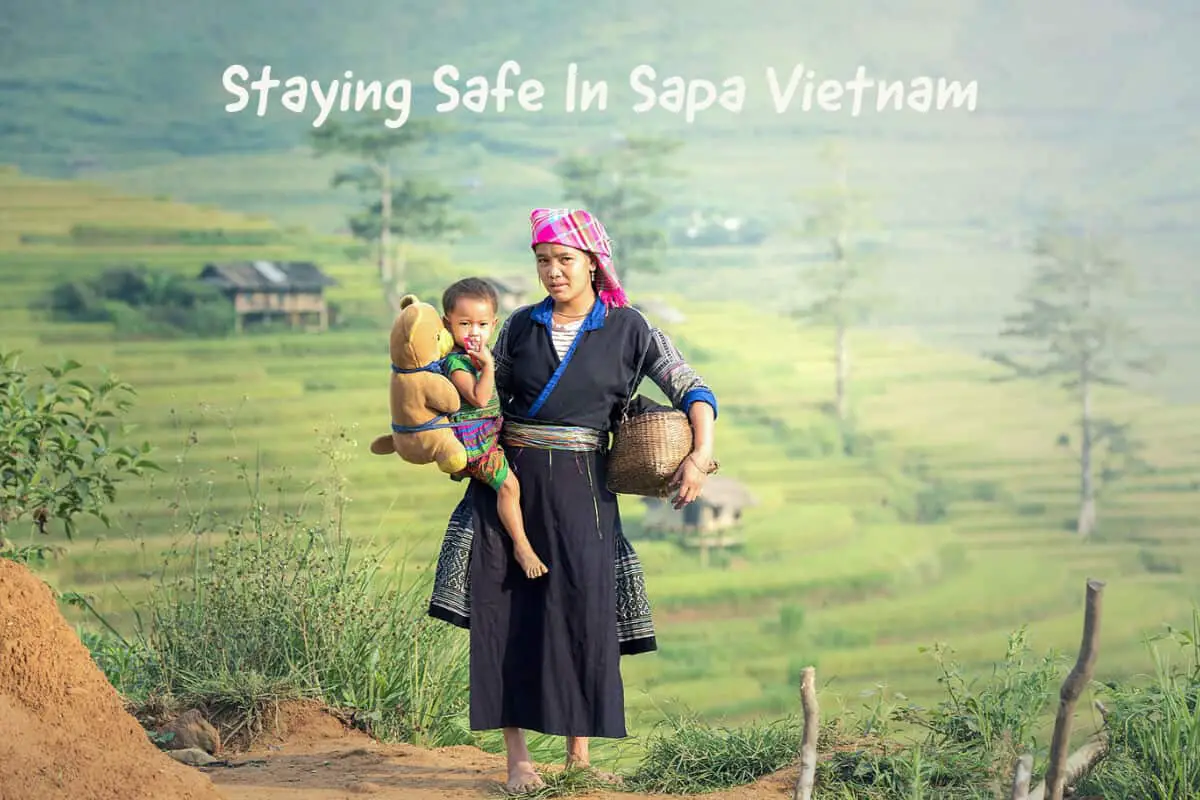I have traveled to Sapa, Vietnam, many times. Sapa is a charming place and well worth the visit.
Sapa, Vietnam, is generally a safe place to travel. While traveling in Sapa, you should take precautions to ensure your safety. Most of the crimes in Sapa are considered a crime of opportunity, which means someone will see your handbag is not secure, so they will grab it. As an extra precaution, while traveling to Sapa, you should only trek in areas you know are safe.
Table of Contents
- Sapa Vietnam Travel and Safety Concerns
- Tips for Traveling Safe In Sapa Vietnam
- How To Get To Sapa, Vietnam
- 10 Reasons Why Sapa, Vietnam is an Unforgettable Travel Destination
- Frequently Asked Questions
- Related Questions
Sapa Vietnam Travel and Safety Concerns
Sapa Vietnam is generally a very safe place for tourists to travel. When you travel to Sapa, you should exercise standard precautions like any other city in Vietnam.
Most of the crimes in Sapa are non-violent, but robberies can happen. When you talk to the Sapa residents, you will find that most of them are very careful with their belonging. Even though Sapa is generally a safe place to travel, there are certain precautions that you should take when traveling there.

Sapa’s Vietnam’s Crimes Are Usually Crimes Of Opportunity
Most of the crimes in Sapa, Vietnam, are non-violent and considered crimes of opportunity. A crime of opportunity means that somehow you left something unsecured, and someone stole it; the thief did not intend to rob you until your careless actions presented them with the opportunity to rob you.
Here are some significant crimes of opportunities in Sapa:
- Pickpockets – The most common crime of opportunity in Sapa is pickpockets. Some children dressed in traditional clothes may be thieves looking for a way to pick their pockets. One of the children may try to keep you occupied, while another will pickpocket you. Most pickpocketing in Sapa is a crime of opportunity.
- Motorbike or Bicycle Theft – Another crime of opportunity that is quite frequent is motorbike or bicycle theft. If you leave your motorbike or bicycle unattended or unsecured, there is a good chance it will be stolen.
- Motorbike Belongings Theft – Motorbike belongings theft is when somebody on a motorbike rides past you and tries to grab your belongings off your motorcycle or even your bicycle. This is a common theft that takes place throughout all of Vietnam. This is why most motorcycles will have a hook or some way to secure handbags and other bags to the bike. Sometimes, when driving down the street, and if your purse is not secure, a Vietnamese person may even warn you to secure it. This is because they know this is a well-known kind of theft in Vietnam.
- Snatch and Grab While Walking – Another widespread crime of opportunity is the snatch and grab while walking down the street. Someone may see that your handbag, backpack, camera, or phone is not secure, so they will come by on their motorbike and grab it.
- ATM Scam Theft – ATM scam theft has increased in Vietnam. A thief may put a camera or device on an ATM to read the card and pin information from those using the machine. Once you have left the ATM, they will use the ATM to withdraw money,
- Taxi Scams – If you use an unauthorized taxi service, there is a chance the taxis will charge you extra money or try to scam you in some way. This is why the best thing you can do is to use taxis only from an authorized service or have your hotel help you get a taxi.
- Trekking in dangerous and unknown locations – Foreigners have died in Sapa while hiking in scary or unfamiliar places. When hiking in Sapa, you must understand the area in which you plan to trek. We suggest you work with a reputable tour company or trek with friends. For a reputable tour company, we recommend Ethos; you can contact them by clicking here or find them on our recommendations page by clicking here.

Tips for Traveling Safe In Sapa Vietnam
Sapa is a relatively safe place to travel. The police in Vietnam work hard to deter crime and keep public safety. When traveling to any place in the world, there are things that you should do to ensure your safety, especially in a location such as Sapa:
Here are some of our top tips to help you stay safe in Sapa:
- Be Careful When Getting In or Out of Buses, Trains, or Taxis – Most people travel to Sapa by bus or train. When you arrive, you may find that you are immediately mobbed and surrounded by people trying to get your attention or to sell you something. During this time, you must be vigilant about your safety and belongings. I suggest you not get caught up in the moment and walk away. You will likely find it cheaper elsewhere, whatever they are selling. This includes not allowing them to follow you or walk you to your hotel.
- Keep Your Belongings Secure – Keep your belongings secure; be responsible for your personal belongings, and do not leave them around or unattended. This is one of the most important things you can do to ensure your safety in Sapa.
- Do Not Fight a Robbery – If someone is robbing you, you should not try to fight it. For example, if someone tries to grab your bag while you are walking down the street and you try to hang onto the bag while they drive off on their motorbike, you could end up severely hurt as you are dragged down the road behind a motorbike. Getting the license number and description would be best, then reporting the robbery immediately to the police.
- Use Common Sense – Use your common sense to stay safe. Do not go trekking yourself, especially in an area you do not know. If a group of people surrounds you and you do not feel safe, walk away.
- Be Alert – Be alert to your surroundings. Be careful to people who might be watching you or following you. If someone looks suspicious, walk away or go in another direction. If they do not stop following or harassing you, call the police or get into a taxi and get away.
- Don’t Flash Your Cash or Wealth – Do not flash your cash or wealth. This is generally a good rule in any place you travel, especially in Sapa, Vietnam. If you get money out of the ATM, do not stand on the street corner, counting it. If you want to count the cash, count it at the ATM or elsewhere. Try to get your money out from an ATM attached to a bank location whenever possible.
Most crimes in a place like Sapa are crimes of opportunity, so the best way to stay safe is to ensure you do not allow anyone to rob you or harm you by being vigilant and using your common sense. Also, do not go wandering off or trekking on your own. I have known several foreigners who have died because they walked alone in locations where they did not fully understand the risk of the terrain they were trekking.
How To Get To Sapa, Vietnam
Safely exploring Sapa, Vietnam, has been my personal experience on multiple occasions, as I’ve never encountered any security issues during my visits. While my trips have been trouble-free, it’s prudent to exercise caution when traveling anywhere.
When planning your journey to Sapa, there are several transportation routes available. Unfortunately, there are no direct flights to Sapa. Instead, you’ll need to fly into an airport in Vietnam, with Hanoi being a popular choice, and then proceed to Sapa.
For a comprehensive array of travel options and routes to Sapa, I recommend visiting the Book a Way website using the link below. They offer a variety of transportation choices to facilitate your travel to this captivating destination.
While Sapa, Vietnam, is generally safe for travelers, it’s wise to stay vigilant and make informed travel choices. Explore the stunning landscapes and vibrant culture of Sapa while keeping your safety a top priority.
10 Reasons Why Sapa, Vietnam is an Unforgettable Travel Destination
Having journeyed to Sapa, Vietnam, numerous times, I’ve been consistently enchanted by its multifaceted allure. Sapa offers a harmonious blend of natural beauty and rich culture in Vietnam’s northern region.
Here are ten reasons, influenced by my own cherished experiences, why Sapa is a must-visit:
- Breathtaking Beauty: Sapa, to me, is a visual masterpiece. The terraced rice fields cascading down the mountainsides, often veiled in a gentle mist, present a sight that’s both serene and majestic.
- Cultural Immersion: Sapa offers a deep dive into Vietnam’s ethnic tapestry. The town and its surroundings are home to several ethnic groups, each with its unique traditions, clothing, and festivals.
- Trekking Paradise: Sapa’s trekking routes are a dream for enthusiasts like me. They wind through valleys, villages, and lush greenery, offering challenge and unparalleled scenic beauty.
- Local Markets: The bustling local markets are a riot of colors and activity. From handwoven textiles to intricate handicrafts, they offer a glimpse into the region’s artisanal brilliance.
- Authentic Homestays: Staying with a local family in a traditional wooden house has always been a highlight for me. It’s an opportunity to experience the local way of life firsthand.
- Cool Climate: Unlike much of Southeast Asia, Sapa boasts a cooler mountain climate. The crisp air and moderate temperatures, especially during the evenings, make it a refreshing getaway.
- Culinary Delights: Sapa’s cuisine is a testament to its rich cultural mosaic. The local dishes, often infused with fresh herbs and unique ingredients, are both flavorful and wholesome.
- Friendly Locals: Each time I’ve visited, I’ve been touched by the warmth and hospitality of Sapa’s residents. Their genuine smiles and stories add a personal dimension to the journey.
- Mount Fansipan: Often dubbed the ‘Roof of Indochina’, Mount Fansipan is Southeast Asia’s highest peak. The trek to the summit, or even the cable car ride, offers panoramic views that are simply unparalleled.
- Sustainable Tourism: Over the years, I’ve noticed an increasing emphasis on sustainable and responsible tourism in Sapa. This ensures that tourism benefits the local community and that the region’s natural and cultural heritage is preserved.
Sapa is not just a travel destination; it’s a mosaic of memories, experiences, and learnings. From its verdant landscapes to its vibrant culture, every aspect of Sapa beckons with the promise of discovery and wonder. Every visit feels like a reunion with an old friend, and every departure leaves me yearning for more.
At A Bus On A Dusty Road, we talk about history, travel, life, sailing, and ex-pat living. We are all about “Living Life As A Global Citizen.” We explore social, cultural, and economic issues and travel.
We would love to have you be part of our community. Sign up for our newsletter to keep up-to-date by clicking here. If you have any questions, you can contact me, Anita, by clicking here.
Listen to our Podcast called Dusty Roads. You can find it on all major podcast platforms. Try out listening to one of our podcasts by clicking here.
Subscribe to our A Bus On A Dusty Road YouTube Channel filled with great videos and information
Frequently Asked Questions
Where is Sapa located in Vietnam?
Sapa is a town located in the Lào Cai Province of northern Vietnam, near the border with China.
How do I get to Sapa from Hanoi?
The most common way to reach Sapa from Hanoi is by overnight train or bus. The train journey takes approximately 8-9 hours, while the bus journey takes around 5-6 hours.
What is the best time to visit Sapa?
The best time to visit Sapa is from March to May and from September to November. During these months, the weather is generally pleasant, and the rice terraces are in full bloom.
What are the main attractions in Sapa?
The main attractions in Sapa include the stunning rice terraces, ethnic minority villages, Mount Fansipan (the highest peak in Indochina), the Sapa Market, and the Silver Waterfall.
Can I do trekking in Sapa?
Yes, trekking is one of the most popular activities in Sapa. There are various trekking routes available, ranging from short and easy walks to multi-day treks that take you through ethnic minority villages and scenic landscapes.
What are the ethnic minority groups in Sapa?
Sapa is home to several ethnic minority groups, including the Hmong, Dao, Tay, Giay, and Xa Pho. Each group has its own unique culture, traditions, and traditional costumes.
Are homestays available in Sapa?
Yes, there are homestays available in Sapa. Staying in a homestay allows visitors to experience the local culture firsthand and interact with the ethnic minority communities.
What should I pack for a trip to Sapa?
It is recommended to pack warm clothing, as the weather in Sapa can be chilly, especially during the winter months. Good trekking shoes, rain gear, sunscreen, insect repellent, and a camera are also essential items to bring.
Related Questions
Is Vietnam Safe For Tourists?
Vietnam is generally a safe place for tourists to travel. But like any country in the world, there are precautions that you need to take to ensure your safety. Most of the Vietnam crimes are considered crimes of opportunity; this means that someone will see that your handbag is not secure, so they will grab it. Or they may see your wallet hanging out of your pocket, so you get pickpocketed. The best thing you can do to ensure your safety is to remain vigilant and use your common sense.
You can read more by reading our blog, Is Vietnam Safe For Tourists? Tips To Stay Safe In Vietnam by clicking here.
Is It Safe To Walk At Night In Hong Kong?
Hong Kong is still a relatively safe city, and Hong Kong is usually safe to walk at night. But with any place you are traveling, there are some precautions you should take when walking around a city you do not know. In recent years, Hong Kong has had some violent protests, which has increased crime. Crime in Hong Kong is considered a crime of opportunity and is not as violent as in other parts of the world.
You can learn more by reading our blog, Is It Safe To Walk At Night In Hong Kong? Tips to Stay Safe In Hong Kong by clicking here.


